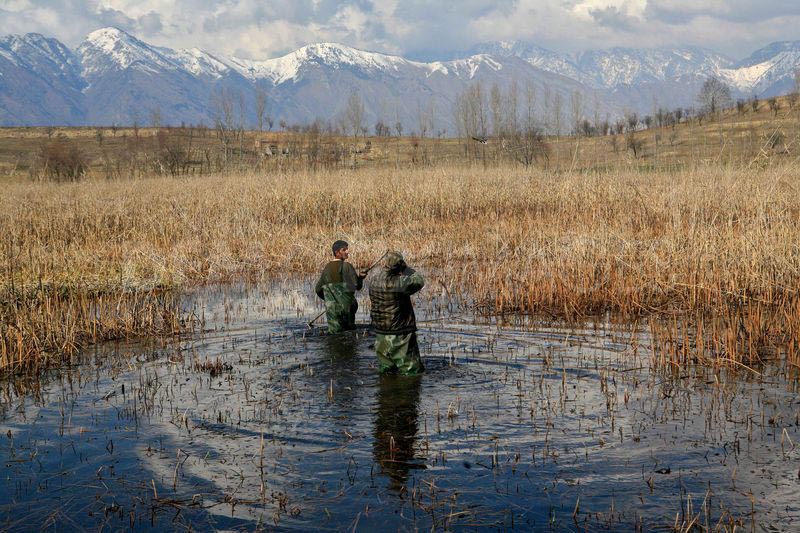
Srinagar- The Jammu and Kashmir government has admitted that the water quality in nine wetlands across Kashmir fails to meet the Class B standards of Designated Best Use (DBU).
Class B of Designated Best Use refers to outdoor bathing, fishing, a healthy aquatic habitat, industrial supply, and agricultural use.
The Central Pollution Control Board has informed the National Green Tribunal (NGT), after the court took cognizance of a report published in a local magazine.
The government informed the NGT that the Biochemical Oxygen Demand (BOD) and Potential of Hydrogen (pH) level in Dal lake and nine wetlands in Kashmir has increased.
The J&K Pollution Control Committee’s analysis confirmed these findings for monitored lakes and wetlands in April 2024. The report also cited issues with solid waste management and illegal dumping affecting several districts.
The report had highlighted the issue of deteriorating condition of wetlands in Kashmir and disclosed that unchecked deposition of millions of tons of sediments annually has led to shallowing of wetlands, elevated temperatures, increased Biochemical Oxygen Demand (BOD) and Potential of Hydrogen (pH) levels.
The NGT had sought a report from the Central Pollution Control Board , Jammu & Kashmir Pollution Control Committee and other stakeholders.
The J&K Pollution Control Committee submitted analytical results of 11 monitored lakes/wetlands in Kashmir vizWular Lake, Anchar Lake, Dal Lake, Hokersar Wetland, Manasbal Lake, Shalbugh Wetland, Hygam Wetland, Freshkoori Wetland, Kranchoo Wetland, Chatlam Wetland & Manibugh Wetland.
The analytical reports for the parameters ph, DO of and BOD reveal that water bodies didn’t qualify the Class B standards of Designated Best Use (DBU) water quality criteria for the month of April, 2024
The JKPCC in its report to NGT also submitted the status of monitoring done by Divisional Officer and factual report of waste dumping in many districts.
In Srinagar, the JKPCC said The dumping of un-segregated Solid Waste was seen at different unfenced collection centers which is afterwards transported by SMC to landfill site at Achan.
In Budgam, the report said Soild Waste dumps/carcases were seen deposited in the Hokersar Wetland which surely comes from the adjoining residential areas enroute the feeding area of Hokersar that finally find its drainage point in the wetland of Hokersar. Grit screen retention nets and barriers are provided but proper management of Municipal Solid Waste is lacking. No cleaning or removal of retained solid waste/ plastic waste has been witnessed since long.
In Ganderbal, the report said that the dumping of unsegregated and untreated Solid Waste at Kohistan Colony Safapora by the concerned ULB/Authority has been witnessed which is approximately one kilometer from the Manasbal lake. Besides, a few dumps of unattended solid wastes near Jharoka park on the Bank of the Manasbal lake at Rather Mohalla also seen.
“The scientific solid waste management is lacking in the area as reported by the field team,” the report said.
In North Kashmir’s Bandipora district, the report said, during inspection dumping of non segregated and untreated solid waste by Municipal Council Bandipora has been witnessed on the Bank of Wullar Lake at Nussu Zalwan Bandipora. The site at which crude dumping of solid waste that too without segregation and treatment is not even fenced and stray animals have easy access to the dumping site.
“Dumping site is at an approximate distance of 100 mts from habitation and at an approximate distance of 200 mts from the educational institute” and in Baramulla, during the inspection no solid waste dump and illegal activities were seen in the area of wetland because the water level of area is very high.
Follow this link to join our WhatsApp group: Join Now
Be Part of Quality Journalism |
Quality journalism takes a lot of time, money and hard work to produce and despite all the hardships we still do it. Our reporters and editors are working overtime in Kashmir and beyond to cover what you care about, break big stories, and expose injustices that can change lives. Today more people are reading Kashmir Observer than ever, but only a handful are paying while advertising revenues are falling fast. |
| ACT NOW |
| MONTHLY | Rs 100 | |
| YEARLY | Rs 1000 | |
| LIFETIME | Rs 10000 | |











